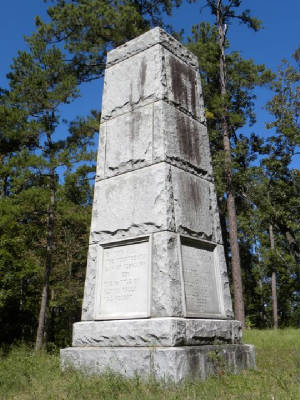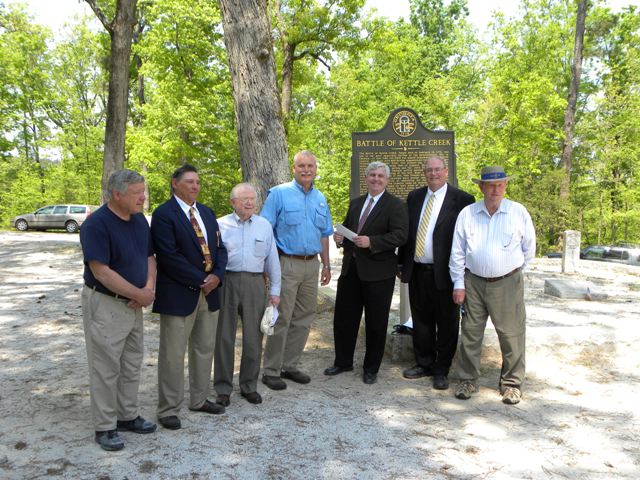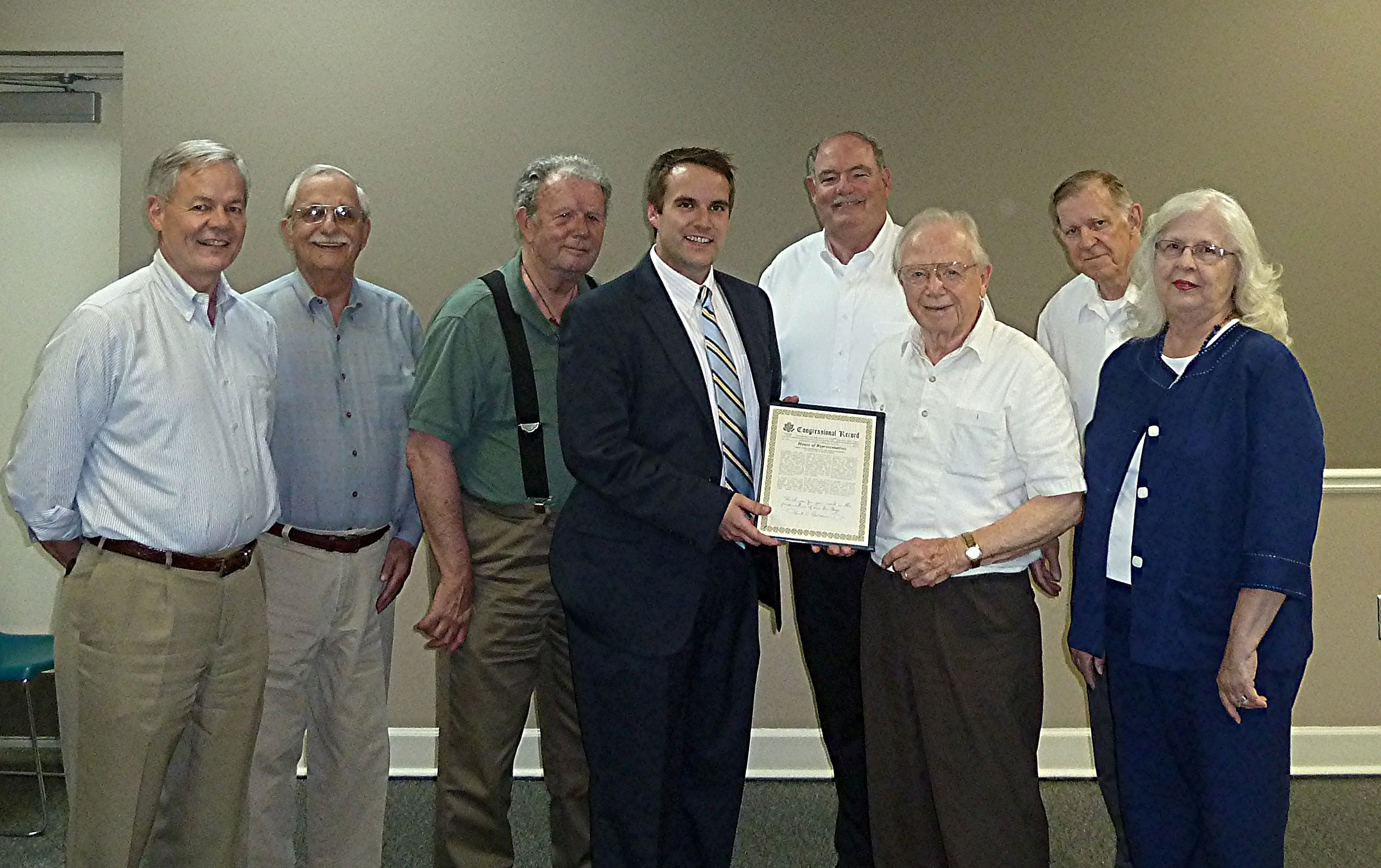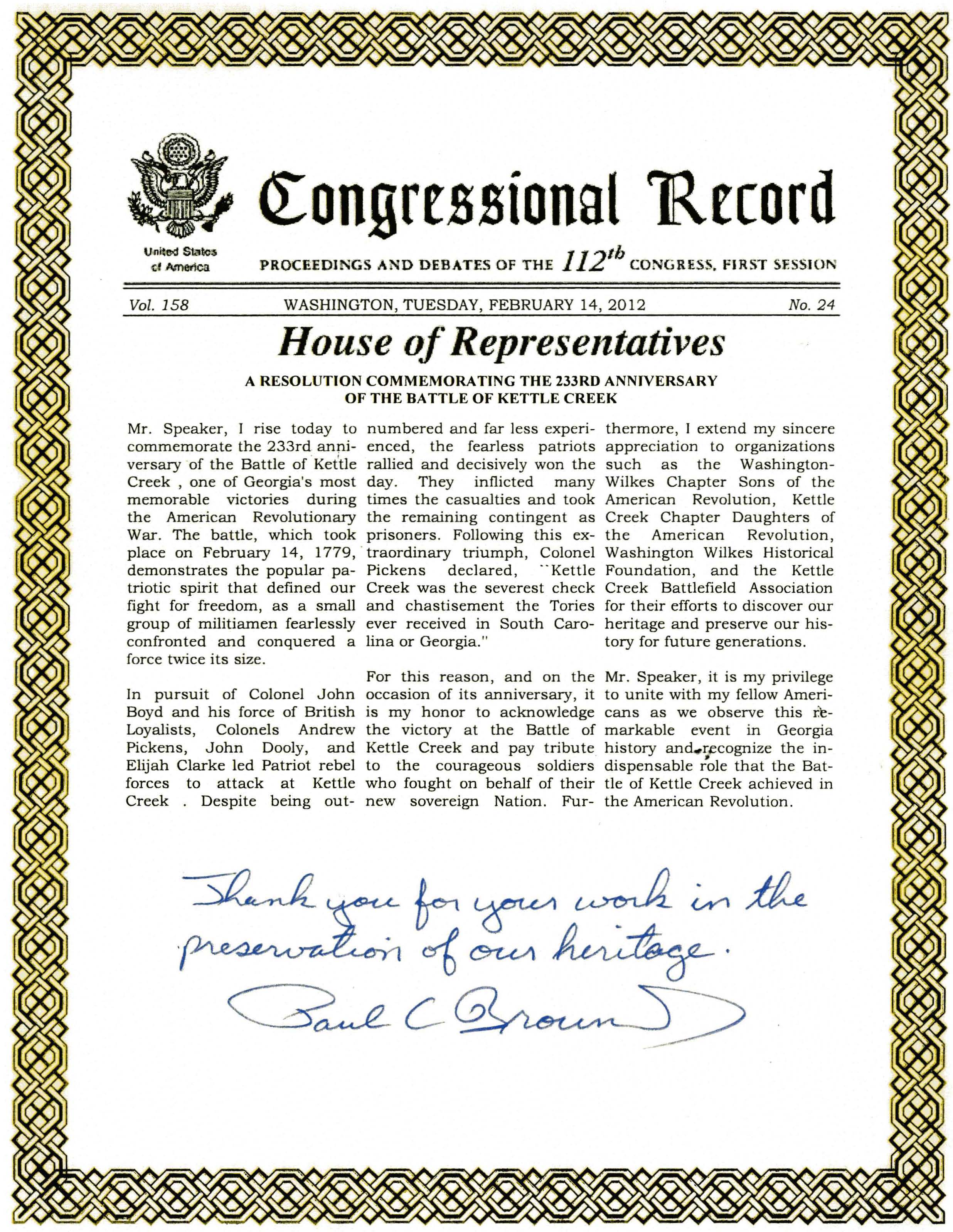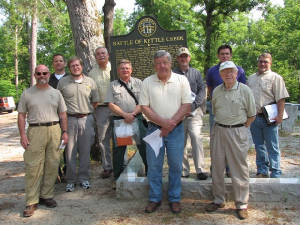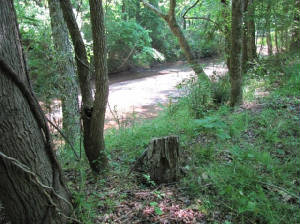|
|
Park Development Plan
Conceptual Plan - Kettle Creek Battlefield Recreational Park Recent History of Site Planning Presented
by the Kettle Creek Battlefield Association MASTER Plan Developed by CSRA (Central
Savannah River Area Regional Commission)….CSRA has been developing the master plan since July 1, 2012 and they have
published what is now the 4th Version of the Master Plan. If you wish to see the development
of the Master Plan click on the link below and a large file will be downloaded to your computer. It is
about 33 MB. Click to download it here: Master Plan by CSRA April 4, 2013
Left Photo: The National Society Daughters of the American Revolution – Kettle Creek Chapter took charge in the 1930’s to place a monument at the Kettle Creek Battle Site-War Hill. One of the Washington Wilkes Chapter members Ed Fluker attended that ceremony when he was a young boy. Right Photo: In June, 2010, members of the
new Washington-Wilkes Chapter Georgia Society Sons of the American Revolution met with an official from the Plum Creek Timber
Company to review the site for the Kettle Creek Battlefield potential park. From L-R: David McClaren, Don Ray Thomas, Dr.
Joseph B. Harris, James R. Rundorff from Plum Creek Timber, INC, David Jenkins, Thomas Owen, and David Chesnut. History of the “War Hill” Federal Monument: The Kettle Creek Chapter of the Daughters of the American Revolution, organized in Washington, Georgia, September 11, 1895, surveyed the “War Hill” property in 1899, and in January of 1900, the chapter purchased “War Hill” – 12 ½ acres for the sum of $75.00. In 1975 the “War Hill” site was placed on the National Register of Historic Places. On January 21, 1980, the property was deeded to Wilkes County, with two acres donated to the chapter by AMAX Forest Products, Inc., for use as a parking lot, a total of 14.5 acres. (In July of 1929, the War Department made an appropriation of $2,500, under the direction of Capt. R. T. Edwards from Fort McPherson. On June 6, 1930, the monument was unveiled with a program that elicited National and State recognition. The inscription on the monument reads:
________________________________________________________________________________________________________________________
The Kettle Creek Battlefield Association is presented with a copy of the Congressional Record Resolution which was publication 2-14-2012 in the Congressional Record . Presenting the Resolution is Mr. Jordan Chinouth, 10th District Director for Honorable Paul Broun, 10th District House of Representatives, and U.S. Congress
Plans for Development and Management A. Development Planning - Kettle Creek Battlefield B. Master Planning Guidelines for Historic Sites C. Overview and Draft Management Plan D. Planning Process E. Existing Conditions and Resources F. Development Alternatives G. Maps and Surveys A. Development and Preliminary Plan
By Dr. Joseph B. Harris The Beginning-First Meeting:
A conceptual plan was presented to the first meeting of the ad hoc Kettle Creek Planning and Development Committee
in February, 2011. This included specific work groups or committees from different stakeholders with an
interest in development: DAR, SAR, military historians and state and local officials. A second step followed
with three motions being passed which directed subsequent planning. Motion: 1. One
of these was to seek state park status; Motion 2: a second was to proceed with committee/work group
development and Motion 3: the third was to proceed toward purchase of land.
In response to motions unanimously supported by the ad hoc committee, officials from the Georgia Department of
Natural Resources (DNR) and the Central Savannah River Area Regional Commission (CSRA RC) were invited to review
the Kettle Creek Battlefield site for evaluation of the park status objective. After two visits and discussions,
a decision was made to fund a park development plan through the CSRA RC and the DNR
with local matching funds. This approach to provide a specific plan is in effect as of April, 2012.
A second response to decisions of the ad hoc committee was the development of a formal organization to continue
development toward park status. The Kettle Creek Battlefield Association, Inc. (KCBA) resulted.
Its mission, goals and objectives were approved in its bylaws on October 12, 2011 and its first meeting was held in
November.
The third directive for development, the purchase of land, is underway following the bylaws of the Association.
Purchase is expected to be achieved in a series of steps as acreage and legal agreements can be reached.
The needed acreage includes those sites of archeologically known value.
In brief, development planning by KCBA proceeds through implementation of its mission and goals
through committees for reaching objectives. The organizational structure includes corporate and Board officers,
committees for site planning and design, education and tourism, funding, land acquisition, publicity and promotion, research
and history. As chairs for the committees and offices are filled and objectives reached, the mission will
be fulfilled. (Copied
from Georgia Department of Natural Resources Historic Planning Guidance- Preservation Planning Guidance) What is a Historic Site Master Plan? Preserving a historic site or property is an admirable
goal. However, to actually achieve that purpose entails more than creating an organization to be “friends” of
the property for advocacy meetings, fund-raising events, scheduling voluntary tour guides, and seasonal maintenance activities.
While effective preservation of a historic site does include
these activities, it also requires a tool specifically dedicated to making all of those things happen: the Historic Site Master
Plan. It is the culmination of all the activities and documentation associated with the overall management of a historic site.
Considerations in developing a
Historic Site Master Plan A Historic
Site Master Plan should be developed as early as possible in the process of determining the future preservation of a property.
It should include the ideas, goals, and visions of all the actively interested parties involved in the preservation process
while also looking to the future so other appropriate ideas may be incorporated at a later date. Primarily, though, the Historic
Site Master Plan should provide the guidance, year-after-year, to use, manage, and pro-tect the property in its historic context.
It should be a much-used reference tool that is regularly revised and updated as circumstances warrant, but which ultimately
keeps the organization administering the historic property continually on the right course. Generally, before or concurrent with developing a
Historic Site Master Plan certain tasks should be completed. These would include preliminary/due diligence feasibility and
marketing studies, the formation of the administering organization as a legal entity, acquisition of the historic property,
formulating preliminary preservation-sensitive ideas regarding the use of the property, and establishing procedures for making
decisions. The first of these helps the group understand some of the underlying challenges of owning a historic site, the
next two provide the mechanism for control of the property, and the last two help get the rest of the plan-ing process started.
In these early stages, the group should also recognize that many decisions are yet to be made and many opinions may need to
be equitably heard and considered in order to guard against pre-conceived notions overly influencing the outcome of the plan.
Furthermore, development
of a Historic Site Master Plan may require consultation with lawyers, architects, accountants, business consultants, preservation
professionals, and other historic sites’ management; this is encouraged when appropriate, such as when in-organization
expertise is not available or when a impartial opinion is needed. Consultation may also save time and effort, as often, prior
experience will provide answers to the unknown and unfamiliar, without the need to reinvent the wheel. 1.
Vision Statement: this should be a short and concise statement of the
purpose and goals of the organization regarding the preservation and use of the historic site (which is not necessarily the
overall mission of the organization). An important part of creating the vision statement is recognizing and incorporating
within it aspects of why the property is historically important—its historic context—and avoiding objectives that
conflict with preservation principles. 2.
Executive Summary: this should summarize the property’s history
and importance, why the Historic Site Master plan is being created, goals for the use of the property, information about the
administering organization, and other important information as applicable. While the executive summary is at the beginning
of the plan document, it should be one of the last things written so that all aspects of the plan contents can be considered
before deciding what should be included. The Executive Summary should be engaging, informative, easy to read by the general
public, and relatively short—no more than two pages. Excerpts from the Executive Summary and the Vision Statement might
also provide text for public relations or educational tools as pamphlets or flyers about the property. 3. Historical Overview:
this should be a highly detailed history of the site, its historical development, its historic
features, buildings and structures, and a chronicle of important people or events associated with the property. If copious
amounts of information about the history of the site are available, then a summary history may be more appropriate, with reference
to a separate historic overview document. An appropriate way to organize and develop a historic overview is to complete a
Historic Property Information Form (HPIF) as part of nominating the property for listing in the National Register of Historic
Places. Applying for listing in the National Register should be an objective within the master plan and when achieved, the
nomination and announcement should be incorporated in the master plan document as well. 4. Organization
Overview and Goals & Objectives for Use of the Historic Site: this section should include
a detailed history of the administering organization and also explain thoroughly how goals and objectives for the use, care,
and management of the historic site were determined and how decisions were made. These goals and objectives should be the
logical result of a decision-making process that collected and considered such relevant information as: preliminary ideas
regarding potential site usage, identification of historic resources on the site and their preservation needs, the historic
context of the site, including association with important events or people, identification of issues beyond the immediate
control of the organization and options for addressing these issues, costs of implementing a goal or objective, and priorities.
Again, while this section of the Historic Site Master Plan is toward the beginning of the document, its final form may be
dependent on information that follows. 5.
Development Plan: this section should be the primary guidance tool for
implementing the goals and objectives for the physical development of the historic site. Initially, the development plan should
provide a general and broad perspective of what will be occurring to the property over time. As related individual projects
are planned and implemented, they should be incorporated or referenced in the development plan section of the master plan.
The development plan should include a site plan identifying historic resources, planned new construction, and other site alterations.
It should also include, as they are developed, rehabilitation plans for the historic resources. 6. Preservation
Plan: this section should be the primary tool for determining the appropriate treatment of the historic
resources on the property. A preservation plan characterizes and evaluates historic resources, provides the necessary information
to responsibly deal with existing issues and concerns about the resources and plan for their future, guides implementation
of recommendations resulting from the plan, and acts as a reference source. Incorporated within the preservation plan should
be acknowledgement of the Secretary of the Interior’s Standards for the Treatment of Historic Properties and
a Maintenance Plan. Associated documents include inventories of historic collections, photo-documentation of the site, Conditions
Assessment Reports, Historic Structures Reports, other applicable reports, and archaeological studies. These may be included
within the preservation plan or developed separately and incorporated. For
related information see: Preservation Plan Guidelines for Historic Properties, Historic Structure Report Guidelines, Conditions
Assessment Report Guidelines for Historic Structures, and Structural
Assessment Report Guidelines for Historic Buildings or Structures. 7. Use Plan: this
section should be the primary guidance tool for managing the various types of uses that are planned for the historic site.
Within the use plan should be information on hours of operation, staffing needs, a general maintenance plan, and other day-to-day
operational requirements. It should also outline work plans and task lists for operating the site, assign management responsibilities,
and set schedules. 8.
Disaster Plan: this section should be the primary guidance tool for reacting
to an emergency situation involving the historic site, such as fire or natural disaster. Within the disaster plan should be
information about emergency response measures, including notification responsibilities, emergency decision-making policies,
recovery activity team assignments, and safety procedures. Notification responsibilities, team leader assignments, and other
duties should include back-ups and be designated by position within the organization rather than to an individual to ensure
continuity as terms and personal involvement fluctuate. 9. Interpretation
Plan: this section should be the primary guidance tool for determining and managing how the historic
aspects of the site will be presented to the public. Within the interpretation plan should be information about how historic
collections are displayed and curated, how physical and visual historic resources are explained, and how historical associations,
such as events, important people, and the site’s historic land uses are presented. Also included should be information
about display designs, signage, markers, plaques, and monuments, etc. 10. Business Plan: this section should establish how the administering organization
professionally manages the site. Within the business plan should be information about the management team and board of directors
and their duties and responsibilities in operating the site, including marketing, developing and managing the budget, hiring
practices, purchasing procedures, and contracting for services. 11. Financial Plan: this section should establish how funding the historic
site’s operational and developmental needs will be achieved. Within the financial plan should be information about budgets,
income, expenses, taxes, accounting and auditing practices, user fees, fund-raising activities, projects costs, etc. The financial
plan should be updated on an annual basis. 12. Other Information:
this would include, as applicable, appendices and reference documents. Other Considerations – Master Plan (Continued) The
guidance provided above is intended to be broad but not inclusive. However, all Historic Site Master Plans should have an
introduction, a table-of-contents, and be well organized into logically arranged sections. While the specifics of the contents
in each section are flexible, all the information mentioned should be considered for inclusion in some form or another, and
if not initially, eventually. Recognize that individual plans may require more or less as circumstances warrant and some information
may need to be repeated in more than one section, or frequently referenced as in an appendix. Sometimes it may make sense
to combine sections and use subsections. Also, a Historic Site Master Plan does not have to be contained in one volume; in
a real sense, each of the sub-plans and reports can be stand alone documents, which when combined and cross-referenced become
the master plan. William Hover, Architectural Reviewer Technical Services Unit , Georgia Department of Natural Resources –
Historic Preservation Division August 2008 (rev) C. OVERVIEW AND DRAFT MANAGEMENT PLAN. (Note: The CSRA Regional Commission met with the City
of Washington, the County of Wilkes, state officials,
local members of the GASSAR, Plum Creek Timber Corporation, and others who have
a stake in the preservation/development of the Kettle Creek Battlefield to
determine a vision for the development/preservation.) DATE: July 7, 2011 APPLICANT/CLIENT: Wilkes County Board
of Commissioners/City of Washington CSRA REGIONAL COMMISSION – The Beginning. The
Wilkes County Board of Commissioners and City of Washington (the “Clients”), in partnership with the Wilkes County
Chapter of the Sons of the American Revolution, Kettle Creek Chapter of the Daughters of the American Revolution, and the
Washington-Wilkes Historical Foundation, wish to have prepared a resource protection and conceptual land use plan for the
preservation and development of the site of the Kettle Creek battle of the American Revolutionary War.
The Central Savannah River Area Regional Commission (CSRA RC) proposes to prepare the “Kettle Creek Battlefield Park
Master Plan” (the “Plan”) to fulfill the Clients’ stated needs.
The resulting Plan will serve as a guiding document that provides the Clients with the framework to incrementally realize their vision of establishing a battlefield park that preserves a critical component of American history, increases public recreational and educational opportunities, and augments the further development of the community’s heritage-based tourist economy. Guided by the Clients’ vision of the battlefield park, the Plan will incorporate a conditions analysis of the existing Kettle Creek Battlefield National Register site and surrounding properties, a review of prior historical research, and assessment of funding mechanisms and management options, to propose feasible options for property consolidation and park development. The Plan will provide the Clients with measureable short-term strategies to develop a basic “visitor experience” at the battlefield park in the near term, and long-range objectives and options for further park development. |
||||||||||||||||||||||||||||||||||||||||||||||
WWW.CSRARDC.ORG The Kettle Creek battle site retains those natural characteristics which make
possible the development of a park both recreating the setting for the confused conditions of the 1779 engagement, while offering
the tranquility of today’s natural landscape. (The actual Kettle Creek is shown here.) For the continuation of this report click on the "Park Development Plan" Link below: |
|
|||||||||||||||||||||||||||||||||||||||||||||
|
Webmaster: Wendy Johnson. Send comments to: mailto:kettlecreek@kettlecreekbattlefield.org.
|
||||||||||||||||||||||||||||||||||||||||||||||

